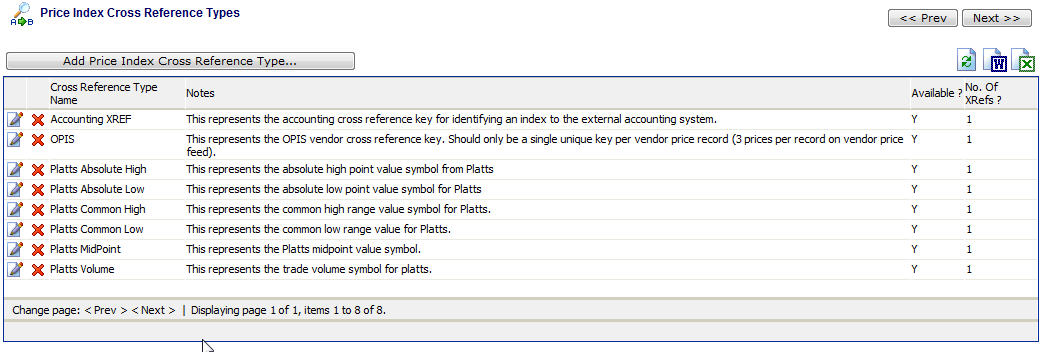Price indices within EnergySteward.com typically make heavy use of cross referencing. The cross referencing capability provides you with a means of storing alternate tags/identifiers for these price indices. A few examples of where these price indices cross references are beneficial include:
| • | [Vender Name] - when you have automated price feeds from vendors, the vendor may hold theses individual prices in names & descriptions that are unique to the vendor. By setting up a vendor cross reference you can associate their names to the names which you use to recognize the price indices. For example, Platts (Gas Daily, Inside Ferc, etc.) contains a uniquely coded identifier for all of it's price indices AND for all price values (Absolute Low, Absolute High, Common Low, Midpoint, etc.). Basically, this is a place to store these vendor translation lists. |
| • | Accounting Identifiers - External accounting system might also store these indices and use EnergySteward.com as the source of this information. Cross references for them allow you to integrate export feeds to accounting and provide them the names THEY use to identify the specific index and value point. |
| • | Other Internal Systems - Any internal system that desires integration is not bound by the names, id's or descriptions within EnergySteward.com . An unlimited number of cross references can be setup to use so that price feeds can be provided throughout an organization. |
| • | etc. |
Important Notes
| 1. | Vendor price feeds (Platts, OPIS, etc.) all require appropriate subscriptions for those feeds through the vendors. |
| 2. | EnergySteward.com includes many AUTOMATED interfaces to these feeds, please contact EnergySteward.com to learn how to activate these additional services. |
The screen shot below shows the initial screen which lists price index cross reference types:

Add Price Index Cross Reference Type (button) - Click this button to add a new cross reference type for price indices.
View/Edit Grid Button (pencil) - Click this next to the applicable cross reference type in order to change the information about the cross reference type.
Delete Grid Button (red x) - Click this next to the applicable cross reference type that you want to permanently delete. When you delete a cross reference type, then all price index associations to this cross reference type will be removed (price indices will still be there, just their association to this type will be permanently deleted). Important note: You will be presented with a confirmation ("Are you sure...?") dialog box prior to deletion.

Cross Reference Type Name - This can be any name for the cross reference type which you want to define. It is suggested that you make this name relatively descriptive for the cross reference in question. The name you post here is what will show up within the pull down list box when setting up price indices.
Notes - This is required and should just be a brief description for the price cross reference type.
Is Cross Reference Type Available (checkbox) - If checked, then this cross reference type is considered active and will therefore show up in the pull down list boxes when setting up price index information. If unchecked then historical status information is maintained BUT when assigning new cross references to price indices, the item will be unavailable (will not show up in the pull down list box).
Max Number of XRef Values - When setting up a cross reference, you can enforce how many instances of the same cross reference identifier can be used for a given cross reference type. For example, if you indicate a '1' in this field (for an "Accounting XREF"). Then when adding/updating a price index, the system will ensure that each cross reference identifier be unique (only 1). You can have "GDPB" price index with an "Accounting XREF" identifier of "GD PermBasin" but if you try to a setup "GDHSC" price index with the same identifier then the system will not allow it (because you already have your max number of cross references met for the type (1) ). Important note: Setting this number to a value other than '1' will allow for multiple indices to use the same identifier. This might be an important requirement with some cross references which you need to setup.